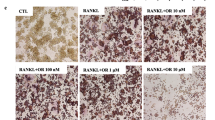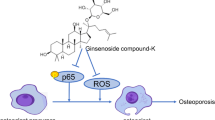Abstract
Statins potently inhibit 3-hydroxy-3-methylglutaryl-coenzyme A reductase, blocking downstream biosynthesis of isoprenoid lipids and causing inhibition of protein prenylation. Prenylated signaling molecules are essential for osteoclast function, consistent with our previous observation that mevastatin can inhibit osteoclast activity in vitro. Several reports suggest that statins may also have an anabolic effect on bone and stimulate osteoblast differentiation. This study sought to determine the effects of both hydrophobic and hydrophilic statins, particularly rosuvastatin (RSV), on osteoclast function in vitro and in vivo. All statins tested (RSV, pravastatin [PRA], cerivastatin [CER], and simvastatin [SIM]) caused accumulation of unprenylated Rap-1A in rabbit osteoclast-like cells and J774 macrophages in vitro and inhibited osteoclast-mediated resorption. The order of potency for inhibiting prenylation in vitro (at concentrations of 0.01–50 μM) was CER > SIM > RSV > PRA. The most potent hydrophilic statin (CER, 0.05 and 0.3 mg/kg) inhibited prenylation in rabbit osteoclasts 24 hours after a single subcutaneous (s.c.) injection more effectively than the most potent hydrophobic statin (RSV, 20 mg/kg). However, in a mouse model of osteoporosis, s.c. 0.05 mg/kg/day CER and 2 or 20 mg/kg/day RSV for 3 weeks only mildly prevented loss of cortical and trabecular bone induced by ovariectomy. No increase in bone formation rate was observed with statin treatment, suggesting that this effect was due to inhibition of osteoclast-mediated resorption rather than increased bone formation.





Similar content being viewed by others
References
Endo A, Tsujita Y, Kuroda M, Tanzawa K (1977) Inhibition of cholesterol synthesis in vitro and in vivo by ML-236A and ML-236B, competitive inhibitors of 3-hydroxy-3-methylglutaryl-coenzyme A reductase. Eur J Biochem 77:31–36
Istvan ES, Deisenhofer J (2001) Structural mechanism for statin inhibition of HMG-CoA reductase. Science 292:1160–1164
Zhang FL, Casey PJ (1996) Protein prenylation: molecular mechanisms and functional consequences. Annu Rev Biochem 65:241–269
Luckman SP, Hughes DE, Coxon FP, Russell RGR, Rogers MJ (1998) Nitrogen-containing bisphosphonates inhibit the mevalonate pathway and prevent post-translational prenylation of GTP-binding proteins, including Ras. J Bone Miner Res 13:581–589
van Beek E, Pieterman E, Cohen L, Lowik C, Papapoulos S (1999) Farnesyl pyrophosphate synthase is the molecular target of nitrogen-containing bisphosphonates. Biochem Biophys Res Commun 264:108–111
Fisher JE, Rogers MJ, Halasy JM, Luckman SP, Hughes DE, Masarachia PJ, Wesolowski G, Russell RG, Rodan GA, Reszka AA (1999) Alendronate mechanism of action: geranylgeraniol, an intermediate of the mevalonate pathway, prevents inhibition of osteoclast formation, bone resorption, and kinase activation in vitro. Proc Natl Acad Sci USA 96:133–138
Bergstrom JD, Bostedor RG, Masarachia PJ, Reszka AA, Rodan G (2000) Alendronate is a specific, nanomolar inhibitor of farnesyl diphosphate synthase. Arch Biochem Biophys 373:231–241
Russell RG, Rogers MJ (1999) Bisphosphonates: from the laboratory to the clinic and back again. Bone 25:97–106
Staal A, Frith JC, French MH, Swartz J, Gungor T, Harrity TW, Tamasi J, Rogers MJ, Feyen JHM (2003) The ability of the statins to inhibit bone resorption is directly related to their inhibitory effect on HMG-CoA reductase activity. J Bone Miner Res 18:88–96
Mundy G, Garrett R, Harris S, Chan J, Chen D, Rossini G, Boyce B, Zhao M, Gutierrez G (1999) Stimulation of bone formation in vitro and in rodents by statins. Science 286:1946–1949
Maeda T, Matsunuma A, Kurahashi I, Yanagawa T, Yoshida H, Horiuchi N (2004) Induction of osteoblast differentiation indices by statins in MC3T3-E1 cells. J Cell Biochem 92:458–471
Corsini A, Maggi FM, Catapano AL (1995) Pharmacology of competitive inhibitors of HMG-CoA reductase. Pharmacol Res 31:9–27
Hamelin BA, Turgeon J (1998) Hydrophilicity/lipophilicity: relevance for the pharmacology and clinical effects of HMG-CoA reductase inhibitors. Trends Pharmacol Sci 19:26–37
Liao JK, Laufs U (2005) Pleiotropic effects of statins. Annu Rev Pharmacol Toxicol 45:89–118
McTaggart F, Buckett L, Davidson R, Holdgate G, McCormick A, Schneck D, Smith G, Warwick M (2001) Preclinical and clinical pharmacology of Rosuvastatin, a new 3-hydroxy-3-methylglutaryl coenzyme A reductase inhibitor. Am J Cardiol 87:28B–32B
David JP, Neff L, Chen Y, Rincon M, Horne WC, Baron R (1998) A new method to isolate large numbers of rabbit osteoclasts and osteoclast-like cells: application to the characterization of serum response element binding proteins during osteoclast differentiation. J Bone Miner Res 13:1730–1738
Reszka AA, Halasy-Nagy J, Rodan GA (2001) Nitrogen-bisphosphonates block retinoblastoma phosphorylation and cell growth by inhibiting the cholesterol biosynthetic pathway in a keratinocyte model for esophageal irritation. Mol Pharmacol 59:193–202
Frith JC, Monkkonen J, Auriola S, Monkkonen H, Rogers MJ (2001) The molecular mechanism of action of the anti-resorptive and anti-inflammatory drug clodronate: evidence for the formation in vivo of a metabolite that inhibits bone resorption and causes osteoclast and macrophage apoptosis. Arthritis Rheum 44:2201–2210
Coxon FP, Helfrich MH, van ‘t Hof RJ, Sebti SM, Ralston SH, Hamilton AD, Rogers MJ (2000) Protein geranylgeranylation is required for osteoclast formation, function, and survival: inhibition by bisphosphonates and GGTI-298. J Bone Miner Res 15:1467–1476
van’t Hof RJ, von Lindern M, Nijweide PJ, Beug H (1997) Stem cell factor stimulates chicken osteoclast activity in vitro. FASEB J 11:287–293
van’t Hof RJ (2003) Osteoclast formation in the mouse coculture assay. Methods Mol Med 80:145–152
Armour KE, Armour KJ, Gallagher ME, Godecke A, Helfrich MH, Reid DM, Ralston SH (2001) Defective bone formation and anabolic response to exogenous estrogen in mice with targeted disruption of endothelial nitric oxide synthase. Endocrinology 142:760–766
Sato M, Grasser W, Endo N, Akins R, Simmons H, Thompson DD, Golub E, Rodan GA (1991) Bisphosphonate action. Alendronate localization in rat bone and effects on osteoclast ultrastructure. J Clin Invest 88:2095–2105
Thompson K, Rogers MJ, Coxon FP, Crockett JC (2006) Cytosolic entry of bisphosphonate drugs requires acidification of vesicles after fluid-phase endocytosis. Mol Pharmacol 69:1624–1632
Shipman CM, Croucher PI, Russell RG, Helfrich MH, Rogers MJ (1998) The bisphosphonate incadronate (YM175) causes apoptosis of human myeloma cells in vitro by inhibiting the mevalonate pathway. Cancer Res 58:5294–5297
van Beek E, Lowik C, van der Pluijm G, Papapoulus S (1999) The role of geranylgeranylation in bone resorption and its suppression by bisphosphonates in fetal bone explants in vitro: a clue to the mechanism of action of nitrogen-containing bisphosphonates. J Bone Miner Res 14:722–729
Benford HL, Frith JC, Auriola S, Monkkonen J, Rogers MJ (1999) Farnesol and geranylgeraniol prevent activation of caspases by aminobisphosphonates: biochemical evidence for two distinct pharmacological classes of bisphosphonate drugs. Mol Pharm 56:131–140
Thompson K, Rojas-Navea J, Rogers MJ (2006) Alkylamines cause Vγ9Vδ2 T-cell activation and proliferation by inhibiting the mevalonate pathway. Blood 107:651–654
Warwick ML, Dane AL, Raza A, Schneck DW (2000) Single- and multiple-dose pharmacokinetics and safety of the new HMG-CoA reductase inhibitor ZD4522. Atherosclerosis 151:39
Wang PS, Solomon DH, Mogun H, Avorn J (2000) HMG-CoA reductase inhibitors and the risk of hip fractures in elderly patients. JAMA 283:3211–3216
Meier CR, Schlienger RG, Kraenzlin ME, Schlegel B, Jick H (2000) HMG-CoA reductase inhibitors and the risk of fractures. JAMA 283:3205–3210
Scranton RE, Young M, Lawler E, Solomon D, Gagnon D, Gaziano JM (2006) Statin use and fracture risk: study of a US veterans population. Arch Intern Med 165:2007–2012
Rejnmark L, Vestergaard P, Mosekilde L (2006) Statin but not non-statin lipid-lowering drugs decrease fracture risk: a nation-wide case-control study. Calcif Tissue Int 79:27–36
Reid IR, Hague W, Emberson J, Baker J, Tonkin A, Hunt D, MacMahon S, Sharpe N (2001) Effect of pravastatin on frequency of fracture in the LIPID study: secondary analysis of a randomised controlled trial. Lancet 357:509–512
Rejnmark L, Buus NH, Vestergaard P, Heickendorff L, Andreasen F, Larsen ML, Mosekilde L (2004) Effects of simvastatin on bone turnover and BMD: a 1-year randomized controlled trial in postmenopausal osteopenic women. J Bone Miner Res 19:737–744
Reid IR, Tonkin A, Cannon CP (2005) Comparison of the effects of pravastatin and atorvastatin on fracture incidence in the PROVE IT-TIMI 22 trial—secondary analysis of a randomized controlled trial. Bone 37:190–191
Gutierrez GE, Lalka D, Garrett IR, Rossini G, Mundy GR (2006) Transdermal application of lovastatin to rats causes profound increases in bone formation and plasma concentrations. Osteoporos Int 17:1033–1042
von Knoch F, Wedemeyer C, Heckelei A, Saxler G, Hilken G, Brankamp J, Sterner T, Landgraeber S, Henschke F, Loer F, von Knoch M (2005) Promotion of bone formation by simvastatin in polyethylene particle-induced osteolysis. Biomaterials 26:5783–5789
Song C, Gui Z, Ma Q, Chen Z, Liu Z, Jia H, Dang G (2003) Simvastatin induces osteoblastic differentiation and inhibits adipocytic differentiation in mouse bone marrow stromal cells. Biochem Biophys Res Commun 308:458–462
Phillips BW, Belmonte N, Vernochet C, Ailhaud G, Dani C (2001) Compactin enhances osteogenesis in murine embryonic stem cells. Biochem Biophys Res Commun 284:478–484
Kaji H, Kanatani M, Sugimoto T, Chihara K (2005) Statins modulate the levels of osteoprotegerin/receptor activator of NFkappaB ligand mRNA in mouse bone-cell cultures. Horm Metab Res 37:589–592
Mendoza S, Noa M, Mas R, Mendoza N (2005) Comparison of the effects of D-003, a mixture of high-molecular weight aliphatic acids from sugarcane wax, and pravastatin on bones and osteoclast apoptosis of ovariectomised rats. Drugs Exp Clin Res 31:181–191
Grasser WA, Baumann AP, Petras SF, Harwood HJ Jr, Devalaraja R, Renkiewicz R, Baragi V, Thompson DD, Paraklar VM (2003) Regulation of osteoclast differentiation by statins. J Musculoskelet Neuronal Interact 3:53–62
Woo JT, Kasai S, Stern PH, Nagai K (2000) Compactin suppresses bone resorption by inhibiting the fusion of prefusion osteoclasts and disrupting the actin ring in osteoclasts. J Bone Miner Res 15:650–662
Maritz FJ, Conradie MM, Hulley PA, Gopal R, Hough S (2001) Effects of statins on bone mineral density and bone histomorphometry in rodents. Aterioscler Thromb Vasc Biol 21:1636–1641
Holdgate GA, Ward WHJ, Davidson M, Thornton M, March R, Taggart F (2001) Kinetics of inhibition of HMG-CoA reductase by a new statin, rosuvastatin. Atherosclerosis 2(suppl):90
Nezasa K, Higaki K, Takeuchi M, Nakano M, Koike M (2003) Uptake of rosuvastatin by isolated rat hepatocytes: comparison with pravastatin. Xenobiotica 33:379–88
Nezasa KI, Higaki K, Matsumura T, Inazawa K, Hasegawa H, Nakana M, Koike M (2002) Liver-specific distribution of rosuvastatin in rats: comparison with pravastatin and simvastatin. Drug Metab Dist 30:1158–1163
Acknowledgments
This work was funded by a grant from AstraZeneca.
Author information
Authors and Affiliations
Corresponding author
Rights and permissions
About this article
Cite this article
Hughes, A., Rogers, M.J., Idris, A.I. et al. A Comparison between the Effects of Hydrophobic and Hydrophilic Statins on Osteoclast Function In Vitro and Ovariectomy-Induced Bone Loss In Vivo. Calcif Tissue Int 81, 403–413 (2007). https://doi.org/10.1007/s00223-007-9078-1
Received:
Accepted:
Published:
Issue Date:
DOI: https://doi.org/10.1007/s00223-007-9078-1




